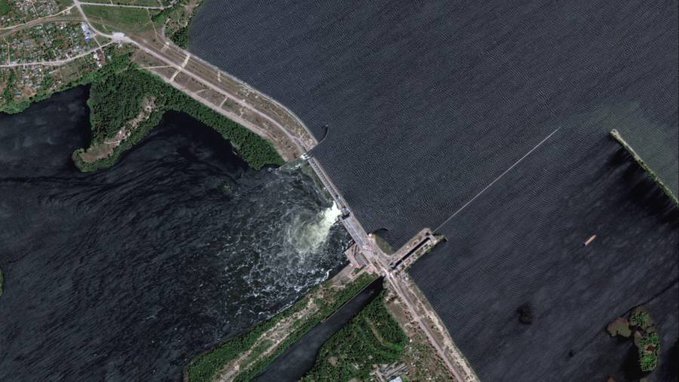The Kakhovka dam in southern Ukraine was destroyed on Tuesday, causing a flood of water to spread across the war zone. Both Ukrainian and Russian forces blamed each other for the destruction of the dam.
TASS reported that 80 settlements could be threatened by the critical water levels caused by the flood. The damaged dam will also lead to issues with water supplies to Crimea, according to the Moscow-installed mayor of Nova Kakhovka.
Circulating videos on social media showed a series of intense explosions around the dam, with bystanders expressing their shock.
The dam was built in 1956 on the Dnipro River as part of the Kakhovka hydroelectric power plant. It holds an 18 km3 reservoir that also supplies water to the Crimean peninsula and the Zaporozhye nuclear plant.
A multi-hundred foot chunk of the Nova Kakhovka dam is gone, the Kakhovka Reservoir is quickly emptying out into the Dnipro. pic.twitter.com/265i1nbvAO
— OSINTtechnical (@Osinttechnical) June 6, 2023
Moscow has repeatedly blamed Kiev for numerous attacks on the Kakhovskaya dam, warning that a breach could result in the deaths of thousands of civilians. In turn, Ukraine has claimed that Russia was planning to blow up the dam in a false-flag operation aimed at framing Kiev for the flooding.
The persistent threat was cited as one of the main reasons for evacuating civilians from certain communities in the area, and an eventual pullout of Russian forces from the city of Kherson to the left bank of the Dnepr River.
Russian military and civilian officials, including acting Kherson Governor Vladimir Saldo, warned at the time that many areas in the region, including the city of Kherson, could be flooded if the Kakhovskaya dam were destroyed.
Ukraine blew up Kakhovka dam as revenge for failed offensive: Kremlin
Ukrainian forces sabotaged the Kakhovka hydroelectric dam in Russia’s Kherson Region in a bid to deprive Crimea of drinking water and distract from Kiev’s faltering counteroffensive, Kremlin spokesman Dmitry Peskov said on Tuesday.
The dam was partially destroyed early on Tuesday morning, sending torrents of water downstream and flooding towns and villages along the path of the Dnieper River.
“We are talking about a deliberate sabotage by the Ukrainian side,” Peskov told reporters. “This sabotage could potentially lead to very serious consequences for several tens of thousands of inhabitants of the region, environmental consequences and consequences of a different nature, which have yet to be established.”
Peskov claimed that one of the key goals of the attack was to deprive Crimea of water. Crimea’s 2 million residents largely receive their water from the North Crimean Canal, which is fed from the reservoir above the Kakhovka dam.
Kherson Region, along with Zaporozhye Region and the People’s Republics of Donetsk and Lugansk, were officially declared part of Russia in early October, following referendums in which the majority of the population voted in favor of the move. However, Kiev and its Western supporters denounced the votes as fraudulent and vowed to regain control over the regions at any cost.
Recently, it has come to light that Ukraine was considering drastic measures to cripple Russian forces who were defending Kherson. According to Major General Andrey Kovalchuk, former head of Ukraine’s Operational Command South, the country contemplated blowing up a dam, a move that could have caused widespread devastation and could have potentially affected civilians in the area.
Kovalchuk revealed in an interview with the Washington Post that Ukraine even conducted a test strike with a HIMARS launcher on one of the floodgates. The general, who now lives in exile, says that the move was designed to prevent Russian troops from moving towards Kherson and to create chaos in the region.
The revelation comes amid heightened tensions between Ukraine and Russia, with the latter amassing troops along Ukraine’s borders in recent weeks. The United States and its European allies have expressed concern over the build-up, while Russia says that it is merely conducting routine military exercises.
Source: RT and Sputnik




